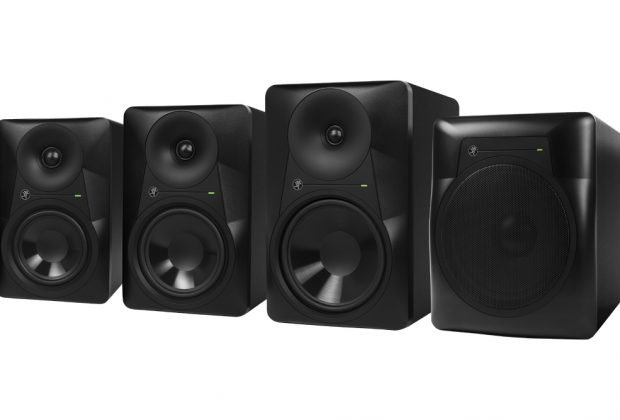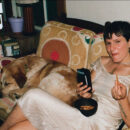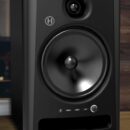Mackie has the latest version of the MR Series powered studio monitors that are designed for home/project studios, small edit bays or multimedia game/content production. The new MR Series now have a three-position Acoustic Space switch to adjust their low-frequency response when positioned close to walls (-2dB) or in corners (-4dB). In addition, there is a high-frequency filter at 3kHz with -2dB, +2dB or flat positions for dialing in high frequencies. Both these features let you set the MRs to work in any room and accurately represent your mix as it really is. Once set up correctly, your mix will "translate" more honestly--i.e. sound like you want it to--outside of your studio (given the specific qualities of the particular sound system you play it on).
Like the previous Mackie MRmk3 Studio Monitors introduced about four years ago, the MR Series are two-way speakers available in three different woofer/cabinet sizes. There are the: 5-inch MR524, 6.5-inch MR624, and 8-inch MR824. Plus Mackie significantly upgraded their 10-inch MRS10 companion powered the subwoofer with both XLR and TRS inputs and outputs and included a jack for a bypass footswitch.
The new MR Series will accept unbalanced line-level audio over an RCA jack, balanced audio lines using the XLR jack, or both balanced and unbalanced line levels using the 1/4-inch TRS input.
My First Look
I received a pair of the MR824s and the MRS10 subwoofer for review and set about to set up a modern 2.1 monitoring system. Immediately from the moment I set them up and started my review process, I realized that the new MR Series are much improved over the previous MRmk3 series. Mackie says: "we are borrowing design elements from our flagship HR and XR Series, so we offer incredible fidelity and accuracy at prices that fit into even more conservative budgets."
The new Mackie MR monitors have an overall "smooth" look with a sculpted front panel, flat black matte finish and slick-looking woofer cones. Mackie's proven logarithmic tweeter waveguide spans a larger portion of the front on this model and blends almost seamlessly into the front surface.
Said to provide an ultra-wide listening sweet spot and wider listening area, I found the speakers not to "beam" the highs so it is not necessary to be exactly on the centerline of the two MR824s to get stereo sound. All of these new monitors have a similar front-mounted sliver of a green, power-on LED opposite the Mackie "Running Man" logo.
The MRS10 has an Auto Power On/Off mode that when engaged and after 13-minutes of no sound, shuts down. When off in this mode, the green LED slowly pulsates. Cool idea!
All Good Changes
Besides different woofer/cabinet sizes, all three have 1-inch silk dome tweeters and redesigned woofers made from polypropylene. The three sizes all use two Class A/B power amps with similar power ratings as before. The cabinets are rear-ported including the new MRS10 subwoofer that uses a 120-watt Class-D amp. All the monitors have over-excursion protection filters--12dB/octave high pass filters to protect against super low frequency "thumps" below the woofer's usable range. The rear panel's heat sink also has an automatic thermal protection cutoff switch if the monitor gets too hot caused by poor air ventilation (cooling) along with continuous loud operation.
I set up the two MR824s left and right on the very edge of the long 70-cm high table center-positioned in my living room--the center of the woofers measured 1.7-meters apart. The MRS10 subwoofer went on the floor positioned and centered exactly equidistant from the two MR824s--I positioned the front of all three speakers exactly 1.7-meters from the wall behind them.
The MRS10 has a polarity switch and, depending on where the listening position is, I would flip polarity for the most consistent low-frequency sound. It remains in the 0-degree position--in polarity with the two MR824s.
I would caution here that setting up a subwoofer for proper operation can be tedious with trial and error to get it right--I use a measurement microphone and software to arrive at the sub's exact level, crossover frequency and its distance relative to the front wall behind it and its polarity. All of those parameters are adjustable on the back of the MRS10 and you can arrive after using and getting use to them in your room. Every installation is different!
I used the A or Normal switch position for Acoustic Space--this would be for monitors that are free standing and sufficiently away from front and side walls. However besides this "Flat" position, use position C or -4dB if the monitors are placed in corners or B for -2dB if the monitors are positioned close to the wall behind them. Four Included small rubber acoustic isolation pads will decouple the vibrating monitor's cabinet from the desk or stand.
I found using the +2dB position for high frequency good for my living room space that has quite a bit of absorption from the carpeting, furniture and drapes but that could change as I get more hours of use on these. I prefer a bright sound and it is nice to know I am not locked into it just yet.
I liked using the MRS10 subwoofer bypass footswitch when playing music at subdued background levels. However for EDM, Rap or Hip-Hop, kick the sub back in to get the party started! On their own, the MR824s have loads of bass, especially in smaller rooms. The individual manuals for the three monitors give a "good starting point" for setting the MRS10's crossover frequency and level but ultimately it is your own ears, your room's size and the exact location of the MRS10 that will determine what sounds good.
I found these new MR Series to be solid workhorses and, by far, the "Best in Class." They will instantly improve the sound of any small studio, edit room, or project studio without breaking the bank.
The Mackie MR Series powered monitors are sold separately; the 5-inch MR524 at $209.99, the 6.5-inch MR624 at $279.99 and, as tested, the 8-inch MR824 sells for 349.99 MSRP. The 10-inch MRS10 sells for $559.99.
http://mackie.com/products/mr-series
Barry Rudolph is a recording engineer/mixer who has worked on over 30 gold and platinum records. He has recorded and/or mixed Lynyrd Skynyrd, Hall & Oates, Pat Benatar, Rod Stewart, the Corrs and more. Barry has his own futuristic music mixing facility and loves teaching audio engineering at Musician’s Institute, Hollywood, CA. He is a lifetime Grammy-voting member of NARAS and a contributing editor for Mix Magazine. barryrudolph.com













